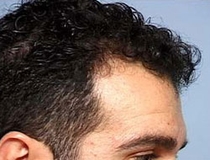
The NeoGraft procedure updates the current surgical hair transplantation scene with the use of an automated device wielded by surgeons to remove individual hair follicles and transplant them to other areas of the scalp. The high degree of precision available to surgeons with the NeoGraft device allows follicular transfer procedures multiple advantages, including no visible scarring, no post op pain and a more even final product. Board certified plastic surgeon, Dr. Brad Calobrace of Louisville, Kentucky, explains the exciting benefits of this new technology.
By Brad Calobrace, MD
and Adam McMillon
ThePlasticSurgeryChannel.com
For those looking to grow new hair and avoid visible scars…

In addition, the immediate recovery period of the operation produces considerable pain and discomfort, due to the skin being stretched to fill the gap of the removed skin strip. The NeoGraft procedure reverses these issues by utilizing an automated machine to precisely extract individual follicles from the patient’s scalp.
Precision, Precision, Precision
Before, follicular unit extraction (FUE) success maxed out at the surgeon’s ability to manually remove and replace hair follicles. With the NeoGraft device, surgeons are given a tool that can be used to precisely harvest individual follicles all the same size. This precision allows follicles to be removed from varying areas on the back of the head, rather than having to remove an entire strip of skin. Calobrace says NeoGraft makes it possible for surgeons to remove and transplant up to 2000 grafts in one sitting, rather than 3-400 in traditional strip grafting. “The ability to transplant more at one time leads to denser, fuller hair when it begins to grow back in,” says Calobrace.
NeoGraft is an elegant solution for women suffering hair thinning
“The NeoGraft procedure works especially great for women,” says Dr. Calobrace. Hair loss in woman is generally different from men, as the issue is a global thinning of hair, rather than a receding hairline. Utilizing the NeoGraft device, surgeons can remove active follicles and implant them individually all over the scalp to make the patient’s hair denser. Calobrace says the scars are small, and therefore virtually indiscernible when taken and implanted in various areas, rather than all in one. The recovery for women is even better he says, because long hair can be used to cover the area where the hair was removed.
How about results?
After the procedure, the hair in the transplanted follicles will fall out over a period of weeks and take a few months to begin growing. “At five or six months, the patients are worried that they are not getting all that they hoped to get,” says Calobrace. This delay in results is the hardest part of the entire procedure. Calobrace assures his patients not to worry because “at nine months or a year, they’re shocked at how much hair they have.”
NeoGraft: the future of hair transplantation
“NeoGraft is a tremendously exciting procedure for surgeons and patients alike,” says Calobrace. “The ease of the procedure and recovery, matched with the precise and unrivaled results, gives all of those suffering hair loss hope to regrow hair without side effects or physical scarring. It’s few and far between to ever find a patient that is not thrilled.”















Facebook
Twitter
Instagram
YouTube
RSS